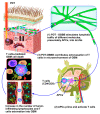Photodynamic Opening of the Blood-Brain Barrier and the Meningeal Lymphatic System: The New Niche in Immunotherapy for Brain Tumors
- PMID: 36559105
- PMCID: PMC9784636
- DOI: 10.3390/pharmaceutics14122612
Photodynamic Opening of the Blood-Brain Barrier and the Meningeal Lymphatic System: The New Niche in Immunotherapy for Brain Tumors
Abstract
Photodynamic therapy (PDT) is a promising add-on therapy to the current standard of care for patients with glioblastoma (GBM). The traditional explanation of the anti-cancer PDT effects involves the PDT-induced generation of a singlet oxygen in the GBM cells, which causes tumor cell death and microvasculature collapse. Recently, new vascular mechanisms of PDT associated with opening of the blood-brain barrier (OBBB) and the activation of functions of the meningeal lymphatic vessels have been discovered. In this review, we highlight the emerging trends and future promises of immunotherapy for brain tumors and discuss PDT-OBBB as a new niche and an important informative platform for the development of innovative pharmacological strategies for the modulation of brain tumor immunity and the improvement of immunotherapy for GBM.
Keywords: blood-brain barrier; glioblastoma; immunotherapy for brain tumors; meningeal lymphatic vessels; photodynamic therapy.
Conflict of interest statement
The authors declare that they have no competing interest.
Figures




Similar articles
-
Music improves the therapeutic effects of bevacizumab in rats with glioblastoma: Modulation of drug distribution to the brain.Front Oncol. 2022 Oct 13;12:1010188. doi: 10.3389/fonc.2022.1010188. eCollection 2022. Front Oncol. 2022. PMID: 36313687 Free PMC article.
-
Photodynamic opening of the blood-brain barrier affects meningeal lymphatics and the brain's drainage in healthy male mice.Biomed Opt Express. 2024 Sep 26;15(10):6063-6072. doi: 10.1364/BOE.527892. eCollection 2024 Oct 1. Biomed Opt Express. 2024. PMID: 39421760 Free PMC article.
-
EEG biomarkers of activation of the lymphatic drainage system of the brain during sleep and opening of the blood-brain barrier.Comput Struct Biotechnol J. 2022 Dec 15;21:758-768. doi: 10.1016/j.csbj.2022.12.019. eCollection 2023. Comput Struct Biotechnol J. 2022. PMID: 36698965 Free PMC article.
-
Nanomedicine in Clinical Photodynamic Therapy for the Treatment of Brain Tumors.Biomedicines. 2022 Jan 3;10(1):96. doi: 10.3390/biomedicines10010096. Biomedicines. 2022. PMID: 35052776 Free PMC article. Review.
-
Understanding the glioblastoma tumor biology to optimize photodynamic therapy: From molecular to cellular events.J Neurosci Res. 2021 Apr;99(4):1024-1047. doi: 10.1002/jnr.24776. Epub 2020 Dec 28. J Neurosci Res. 2021. PMID: 33370846 Review.
Cited by
-
Low-Level Laser Treatment Induces the Blood-Brain Barrier Opening and the Brain Drainage System Activation: Delivery of Liposomes into Mouse Glioblastoma.Pharmaceutics. 2023 Feb 8;15(2):567. doi: 10.3390/pharmaceutics15020567. Pharmaceutics. 2023. PMID: 36839889 Free PMC article.
-
Photostimulation of brain lymphatics in male newborn and adult rodents for therapy of intraventricular hemorrhage.Nat Commun. 2023 Sep 29;14(1):6104. doi: 10.1038/s41467-023-41710-y. Nat Commun. 2023. PMID: 37775549 Free PMC article.
-
Promising Strategies to Reduce the SARS-CoV-2 Amyloid Deposition in the Brain and Prevent COVID-19-Exacerbated Dementia and Alzheimer's Disease.Pharmaceuticals (Basel). 2024 Jun 16;17(6):788. doi: 10.3390/ph17060788. Pharmaceuticals (Basel). 2024. PMID: 38931455 Free PMC article. Review.
-
Photodynamic therapy and associated targeting methods for treatment of brain cancer.Front Pharmacol. 2023 Sep 28;14:1250699. doi: 10.3389/fphar.2023.1250699. eCollection 2023. Front Pharmacol. 2023. PMID: 37841921 Free PMC article. Review.
-
New Insights on Mechanisms and Therapeutic Targets of Cerebral Edema.Curr Neuropharmacol. 2024;22(14):2330-2352. doi: 10.2174/1570159X22666240528160237. Curr Neuropharmacol. 2024. PMID: 38808718 Free PMC article. Review.
References
-
- Mitusova K., Peltek O.O., Karpov T.E., Muslimov A.R., Zyuzin M.V., Timin A.S. Overcoming the blood–brain barrier for the therapy of malignant brain tumor: Current status and prospects of drug delivery approaches. J. Nanobiotechnol. 2022;20:412–463. doi: 10.1186/s12951-022-01610-7. - DOI - PMC - PubMed
-
- Brain, Central Nervous System. [(accessed on 11 April 2022)]. Available online: https://gco.iarc.fr/today.
Publication types
Grants and funding
LinkOut - more resources
Full Text Sources

